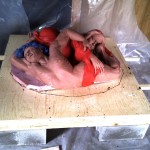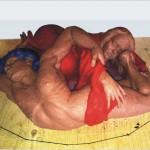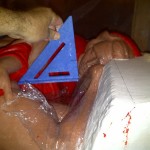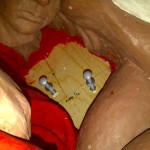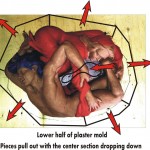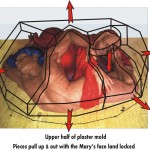Michelangelo would normally not have created plaster castings of his maquettes. He would either fire the clay as is, or simply allow the sun to dry the template.
Under protest, he was commissioned to create a bronze sculpture of Pope Julius ll, and complained in writing to his family how the process was exceptionally challenging. The Maquette he used was full size and weighed almost as much as the final bronze.
Plaster mold making is still a very time intensive proposition. Tremendous care and attention must be applied to how each piece will fit together and release apart.
The final puzzle must lock into place and be able to support its own weight and the weight of the clay pushed or poured inside.
In the case of my Pieta, the combined material weight could exceed 1000 lbs. The work platform will need to be sturdy and of sufficient area to build wooded forms and contain any plaster spills. Once my Maquette is centered on the decking, a close examination will be needed to plan each piece of this mold…
The mold will need to pull directly off of the statue, and so there can not be any undercuts. If the plaster cast is tucked behind a fold or curve of the Maquette, this portion will be shaved off as the piece is pulled away. Or worse, the piece will be locked in and unable to be released.
Mary’s face, for instance, is resting on Jesus’ foot and is tucked behind her arm and his hand. In order for the plaster mold to be able to be pulled off and away from her face, there will need to be room for the piece to move out several inches. In effect, I will need to have additional plaster sections of this puzzle to drop down or slide away to allow space for the face segment to move off.
As you will see in upcoming chapters, the final mold will be inverted and then stuffed with clay. Half a ton will need to spin and role without moving or sliding, and so I will need to plan the location of bolts (see tools of the trade) that will be locked within the plaster and will attach to an electric pulley; all needed to help hold and lift the pieces.
This planning stage is straightforward, but critical. Plan in advance the location of the pieces, and ensure you have all the tools and supplies needed. Once you start adding water to plaster, it will be too late.

